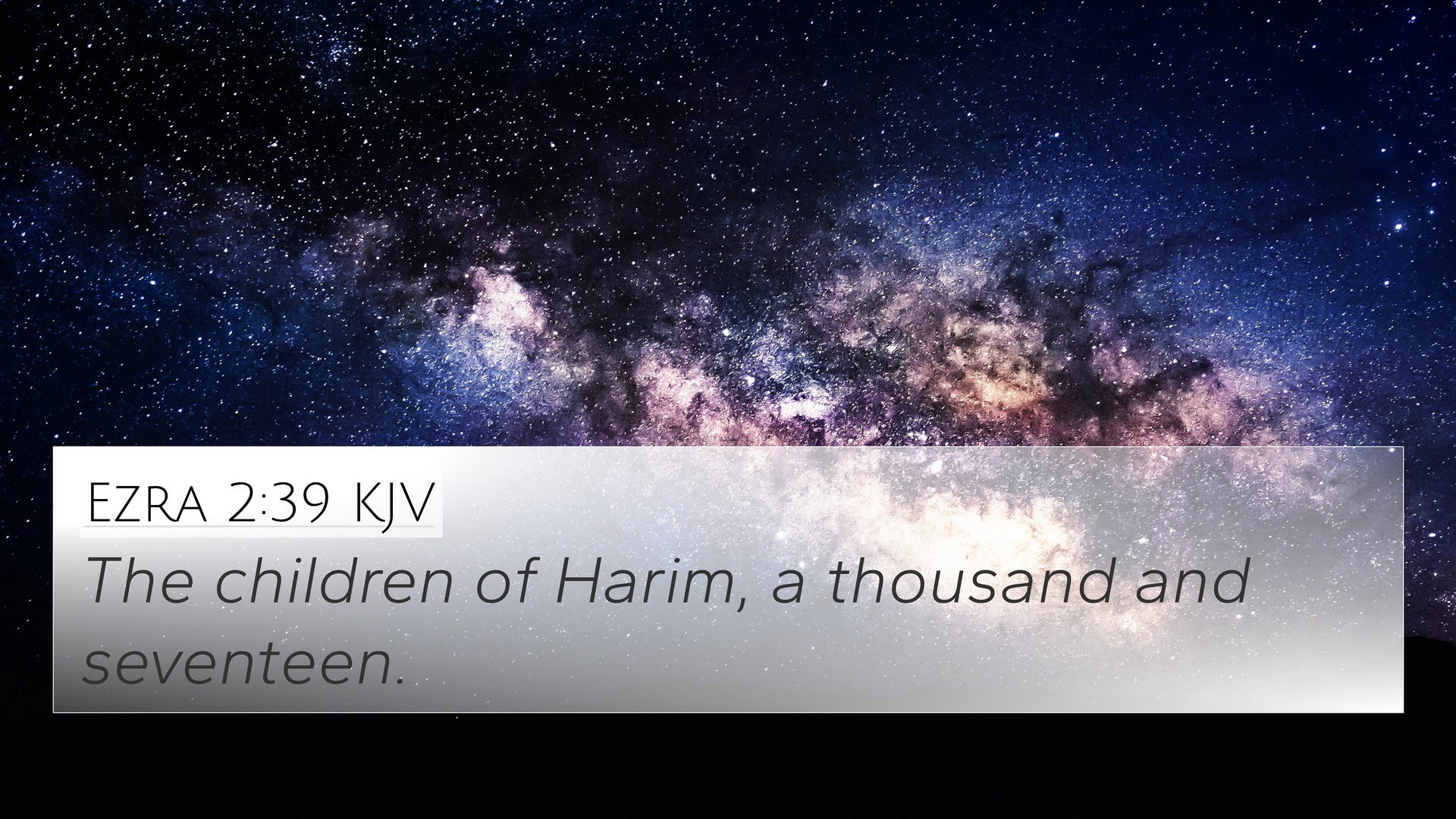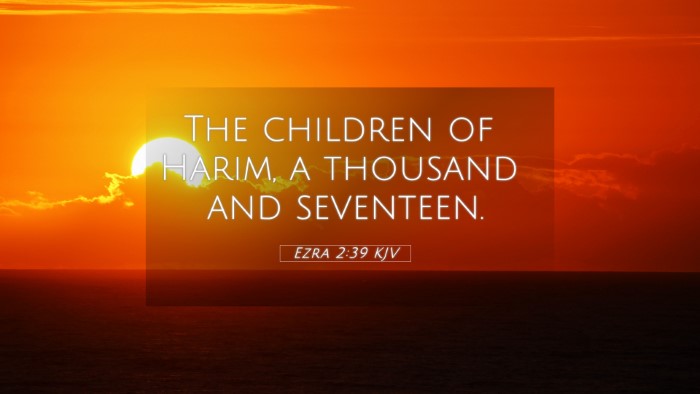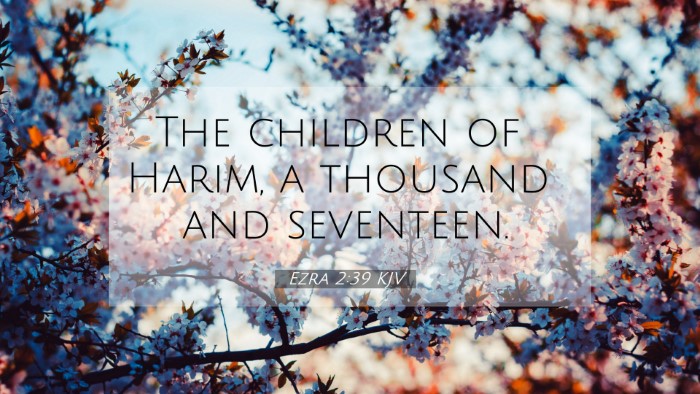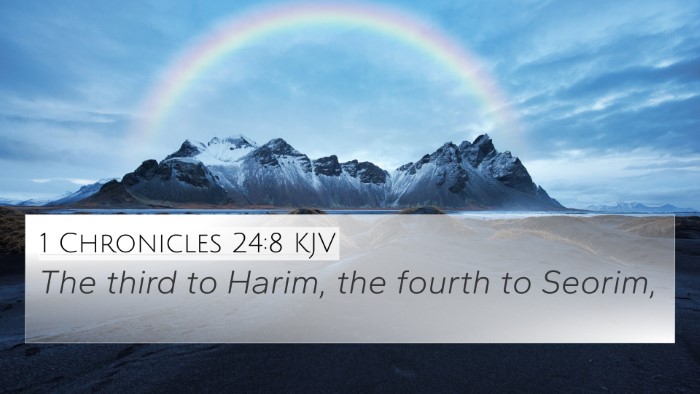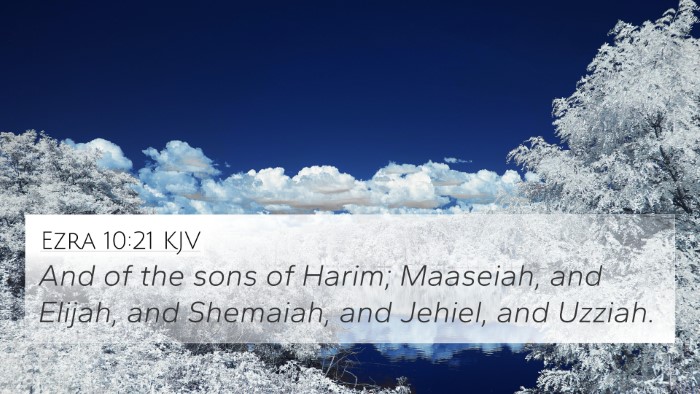Understanding Ezra 2:39
Ezra 2:39 is a significant verse within the context of the return of the Israelites from Babylonian exile. It lists the priests who returned to Jerusalem, emphasizing the importance of priestly lineage and the restoration of worship in the Temple. This verse serves as a reminder of God's faithfulness in preserving a remnant of His people.
Verse Text
The verse states: "The priests: the children of Jedaiah, of the house of Jeshua, nine hundred seventy and three." (Ezra 2:39, KJV)
Commentary Insights
From the insights of respected biblical commentaries such as Matthew Henry, Albert Barnes, and Adam Clarke, we can derive a deeper understanding of this verse:
-
Matthew Henry:
Henry emphasizes that the listing of the priests signifies the importance of priestly roles in Israel's worship. The mention of Jedaiah's descendants indicates God's continued provision for the sacrificial system, reflecting His covenant fidelity.
-
Albert Barnes:
Barnes highlights the strategic nature of this list, noting that it serves as a historical record that establishes the legitimacy of the returning priests. He connects this restoration to the prophetic words in Jeremiah that promised a return and rebuilding.
-
Adam Clarke:
Clarke remarks on the significance of the numbers presented. The count of 973 priests implies a substantial priestly presence, crucial for re-establishing worship practices. He also discusses priestly families, which plays a vital role in understanding Israel's community structure after exile.
Significance of the Verse in Context
This verse epitomizes the larger narrative of restoration in the book of Ezra. The return from exile, accompanied by lists of those who returned, including priests, signifies God’s faithfulness and the rebirth of Israel's identity centered around the worship of Yahweh.
Bible Verse Cross-References
To understand the connections between this verse and others in the Bible, consider the following cross-referenced verses:
- Nehemiah 10:9-11: This passage speaks to the responsibilities of the priests and the covenant made by the people, echoing the themes of dedication found in Ezra.
- Jeremiah 30:18: A prophecy of restoration that directly relates to the return of the exiles and the re-establishment of worship.
- Ezekiel 44:15: References the sons of Zadok who kept God’s charge, inviting comparison to the lineages restored in Ezra.
- 1 Chronicles 6:16-30: Lists the genealogies of priests, providing context for Ezra 2:39.
- Exodus 28:1: Highlights the importance of the priestly role established from the beginning of Israel’s covenant relationship with God.
- Hebrews 7:14: Ties the Levitical priesthood to Christ, illustrating the ultimate fulfillment of the priestly line.
- Matthew 1:12: Contains geneaological links to the priests, emphasizing Jesus’ connection to legal priestly lineage through Joseph.
Connections Between Bible Verses
These references illustrate thematic connections throughout Scripture, showcasing God's ongoing work and covenant faithfulness:
-
Restoration Themes: Both Ezra 2:39 and Jeremiah 30:18 highlight the restoration of the priesthood and the anticipated return to worship.
-
Priestly Duties: Nehemiah's mention of the priests’ roles complements Ezra’s account, emphasizing collective responsibility in worship.
-
Genealogical Importance: The link to 1 Chronicles provides a deeper understanding of how God preserved His people.
Understanding Through Cross-Referencing
The practice of cross-referencing Biblical texts allows us to explore the unity of Scripture. Observing how Ezra 2:39 interlinks with passages in both the Old and New Testaments reveals a coherent narrative of God’s faithfulness, highlighting how the past informs the present understanding of God's purpose.
Cross-Referencing Resources
For those looking to dive deeper into the connections in the Bible, consider using Bible cross-reference guides or establish Bible chain references. Tools like a Bible concordance are invaluable for exploring inter-Biblical dialogue and identifying connections like those between Ezra and Hebrews.
Conclusion
Ezra 2:39 is more than a historical record; it symbolizes the fidelity of God to His promises and the importance of covenantal worship in the life of Israel. Cross-referencing this verse with others enhances our understanding of Biblical themes and God's redemptive plan manifested throughout Scriptures.
